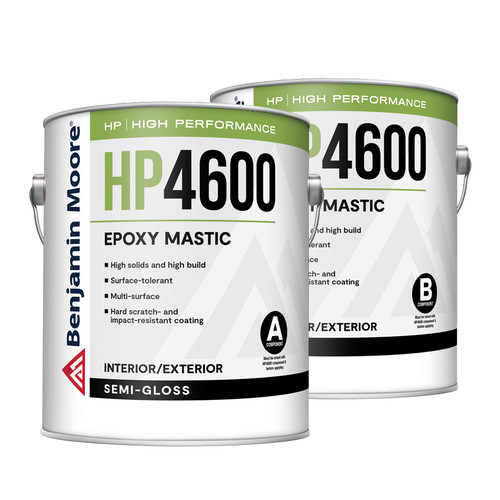Product Overview
*****FREE SHIPPING*****
2 GALLON KIT INCLUDES A & B
Benjamin Moore HP4600 Epoxy Mastic (formerly Corotech V160) is a high-solids, surface-tolerant epoxy coating engineered for demanding industrial environments where superior chemical, abrasion, and impact resistance is required.
Designed for direct-to-metal and masonry applications, HP4600 adheres to hand-prepared rusty steel, abrasive blast-cleaned surfaces, hydro-blasted ferrous metals, and blasted concrete, making it a top choice for maintenance and protective coatings. Its high-build formulation delivers long-term rust prevention and exceptional durability, even in coastal or marine environments, as well as secondary containment and immersion applications.
KEY FEATURES:
- Formerly Corotech V160
- High-solids, high-build epoxy mastic
- Excellent rust prevention and chemical resistance
- Surface-tolerant – adheres to minimally prepared steel
- Impact and scratch-resistant finish
- Ideal for immersion service in fresh or salt water
- Versatile application on ferrous and non-ferrous metals, concrete, masonry, and aged coatings
SHEEN: Semi-Gloss
COLORS: White, Almost unlimited custom colors.
COMPLIANCE & CERTIFICATIONS:
- FEDERAL
- OTC
- OTC II
- CARB02
- CARB07
- CARB19
- UTAH
- AZMC
- SCAQMD
- MPI 101, 116
- Suitable for Use in USDA Inspected Facilities
POT LIFE: 2 hours @ 77 degrees
INDUCTION TIME: 15 minutes
MIX RATIO: 1:1
COVERAGE: 175-275 sq.ft. per gallon
DRY TIMES:
- To Touch 4 Hours
- To Recoat 12 Hours
- Light industrial use: 72 hours
SURFACE PREPARATION: Surfaces must be clean, dry and free of all grease, dirt, dust, oil and wax. Clean all surfaces using HP6000 Oil & Grease Emulsifier. Remove all remaining loose paint, rust and mill scale via Hand Tool Cleaning (SSPC-SP 2) or Power Tool cleaning (SSPC-SP 3). Fill holes and cracks and sand smooth. Glossy surfaces must be fully deglossed. Moderate to heavily rusted areas must be thoroughly prepared and active rust should be properly removed. All masonry surfaces must be allowed to cure a minimum of 30 days before painting. Acid etch or abrasive blast all slick, glazed concrete or concrete with laitance. For acid etching, follow all manufacturer’s directions and safety instructions. Rinse thoroughly and allow to dry.
PRIMER SYSTEMS:
- Ferrous Metal: HP4600 Epoxy Mastic can be applied directly to prepared ferrous metal In areas where adequate surface preparation is not possible the use of HP1550 Concrete & Metal Epoxy Primer is recommended.
- Galvanized, Aluminum and Non-Ferrous Metals: HP4600 Epoxy Mastic can be applied directly to all non-ferrous metal that has been thoroughly cleaned.
- Concrete and Masonry: Prime concrete with one coat of HP1550 Concrete and Metal Epoxy Primer, or HP1560 Quick Set Epoxy Floor Sealer.
- Previously Painted Surfaces: HP4600 can be applied over most old industrial finishes in good condition. Test patches are recommended to check for wrinkling or lifting of existing coatings. HP1550 Concrete and Metal Epoxy Primer may be used as a barrier coat over all existing coatings.
MIXING INSTRUCTIONS: This is a two-component product and is preproportioned for error free mixing. Mix “A” & “B” separately.
- Carefully empty the entire contents of HP4600 Part B and the contents of HP4600 Part A component resin into a separate metal pail, large enough to hold both Part A and Part B, scraping the sides of both parts to ensure all liquid has been added.
- Using a drill mixer at low speed, blend this mixture for three to five minutes until completely blended. Keep the mixing blade turning at a slow speed to minimize whipping air into material. Scrape sides of pail during the mixing process.
- Allow to induct for 15 minutes at 77 °F (25 °C) prior to application. Pot Life: 2 hours at 77 °F (25 °C)
APPLICATION:
- Airless Spray (Preferred Method): Tip range between .017 and .021. Total fluid output pressure at tip should not be less than 2100 psi.
- Air Spray (Pressure Pot): 704 or 765 air cap and Fluid Tip E.
- Brush: Natural Bristle only
- Roller: Industrial Cover with Phenolic core. ¼” –½” nap.
NOTE: Do not allow material to remain in hoses, gun or spray equipment. Thoroughly flush all equipment with HP7040. Do not thin. Where non-skid characteristics are desired, hand broadcast an appropriate anti-slip aggregate into the wet film then back-roll to encapsulate. All epoxy coatings will chalk and fade if applied on exterior surfaces subjected to direct sunlight. All epoxies tend to yellow. Where color and gloss retention is important, top-coating will be necessary. HP4600 will stain with prolonged exposure to some solvents and chemicals or in kennels if exposed to animal waste. This staining will not affect the durability or protective qualities of the coating. Do not apply if material, substrate or ambient temperature is below 45 °F (7.2 °C). Relative humidity should be below 90%. Do not apply if within 5 degrees of dew point or if rain is expected within 12 hours of application.
LIMITATIONS:
- This product will not cure at surface temperatures below 45 °F (7.2 °C).
- This product will amber and chalk if exposed to sunlight. Where color and gloss retention is important, top-coating will be necessary.
Reviews












